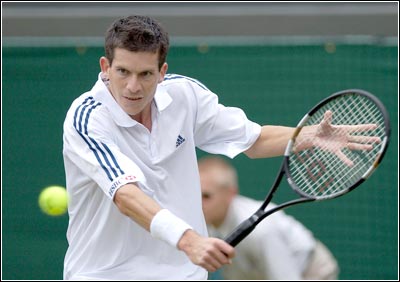'Djokovic is playing some of the best tennis in the history of the game.'
Former British tennis icon Tim Henman discusses the game, the scenario in India and country-man Andy Murray with Bikash Mohapatra/Rediff.com
For someone who won his first professional title in Mumbai back in 1994 to return to the city for a coaching clinic was a sense of deja vu.
Tim Henman was nostalgic. Yes, for a lot had happened in the intervening 22 years.
A total of six semi-final appearances in major tournaments -- four at Wimbledon, a haul of 11 ATP Tour titles, a career-high ranking of No 4 (July 2002) and eventual retirement.
Back to the place where it all began, as an ambassador for the Road to Wimbledon -- a tournament aimed at helping young players improve -- the 41 year old opened up in an elaborate tete-a-tete with Bikash Mohapatra/Rediff.com
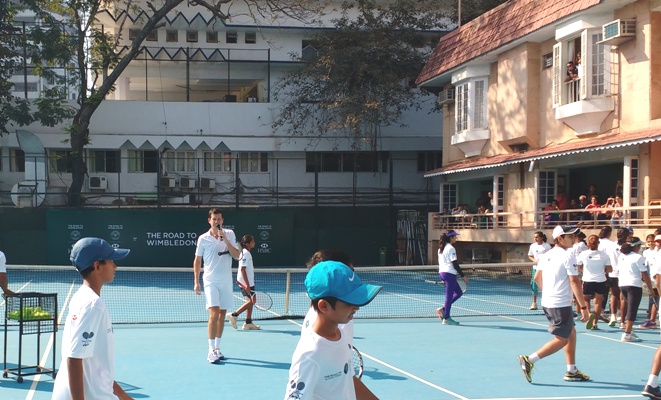
So how does it feel to be in India again?
On a personal level, it is always special to come back to India.
It's where my professional career kick-started. I came here to play in the satellite circuit, the first week happened to be in Mumbai.
It was the first professional tournament I ever won. I went on to win three of the four tournaments scheduled and that helped move my rankings up.
So it's great to be back here and I hope to keep coming back for many more years, not just for this Road to Wimbledon tournament, but also for other opportunities to help kids.
Coming to the Road to Wimbledon tournament, what are you exactly focusing on?
We are focusing on three elements among young Indian players.
There's the skill set, the physicality -- the movement, the stamina and the strength -- and the mental side, the competitive spirit as in how they are able to play point after point.
When we look into the tennis side, I think there are a lot of talented players here, with good hand skills. I think the area we need to look at, on a consistent basis, is physical fitness and stamina in match play.
And you improve this area. When they are physically better, they will improve mentally and have the resilience to compete for longer periods without losing concentration.
I think all the three elements need to be tackled together. You cannot just be good in one and poor in another.
For me, India and Britain are very similar. In Britain most kids play football. In India they take to cricket.
The challenge is to get the best athletes in the country to play tennis. And the way we can do that is to make the game more accessible, to give them more opportunities.
The Road to Wimbledon is a step in the right direction.

But for a sport to be popular in a country you need to have heroes. As regards the Indian players, doubles seems to be a easier route to get instant success. And it is not as popular.
But the likes of Leander Paes and Sania Mirza gave up singles to pursue a career in doubles. Do you think it was a smart move?
I don't know if it is a smart move, but perhaps the only move.
If they are not good enough to play in the singles, they may as well start playing doubles. It provides another opportunity and they can take advantage of the fact that there is not much competition.
I think Leander played singles for a lot of time, and had some success. He is a similar age to me, and he is still playing.
Sania also had some success in singles. But, as I said, if they can't play singles they have to take their opportunity in doubles. And that's what they are doing, at least in terms of results.
But what you are saying is true.
You have some good players, but mainly in doubles. If India can have a world-class singles player, it will change the face of tennis in the country.
Till the early 1990s most singles players also played doubles. There was more competition. Winning a major double was a prestigious achievement. Even during your time we had Yevgeny Kafelnikov and Pat Rafter...
Now it is impossible to play both.
After playing five rigorous sets in a singles match, it is impossible to go and play doubles.
Even when I played, the courts were still faster, and that explains the success of Kafelnikov and Rafter.
But I don't think we will now see the top singles players play doubles ever again.
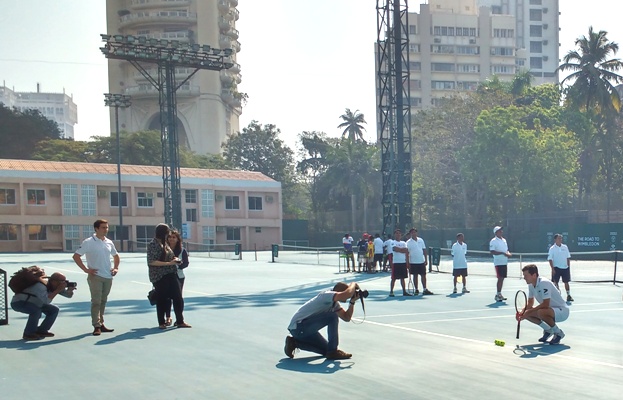
Your professional career coincided with a transitional phase in tennis.
From a time when attacking tennis was played to one when it became a baseline slugfest. Most of the players today play from the back court. In such times how difficult is it for a young player to develop different skills?
It is not very difficult at all for the young players to work on these aspects.
When you are talking about 12, 13 and 14 year olds, it is absolutely vital that they work on all aspects of their game. So it is the first serve, the second serve, the accuracy, the baseline game... we know that is very, very important.
But when you are looking at coming to understand the net game, working on the technique of your volleys, but also your positioning, where to hit the approach shot... if you can instill this at 12, 13 or 14 it becomes much, much easier.
To answer your question in a different way: For the players, when they are 18, 19 or 20 years of age, to start working on their net game -- if they have not done that before --; it's very, very difficult. And it's probably too late.
So it's very important that if they are to understand how to attack the net, they should do so at an early age.
The problem with the modern game is, with the courts being slower, the players quicker from the back of the court are a little bit intimidated coming to the net because they feel that they are going to lose the point more easily.
But if they are going to learn the net game now, even when losing a few points, they will have the physicality to cover the net when they are 18, 19 or 20. The net is still a great area to play from.
How much of a role does the quality of rackets, and the balls involved, now play as regards influencing the style of play?
I think the rackets haven't changed much. If you look at it, (Roger) Federer is using the same racket (Wilson) that (Pete) Sampras was using; the same racket that (Stefan) Edberg was using, and that goes back to the mid 1980s.
One area that has changed enormously is the strings. With synthetic strings, the players are able to string their rackets a little bit loose.
That gives them more spin, more control and a bigger sweep shot. So when you see the manner in which the players can control the point from the back of the court, it's got to do with that.
It's difficult for the players to come to the net. With their opponents moving faster they have very little time to cover the court. Yes, there are challenges coming to the net.
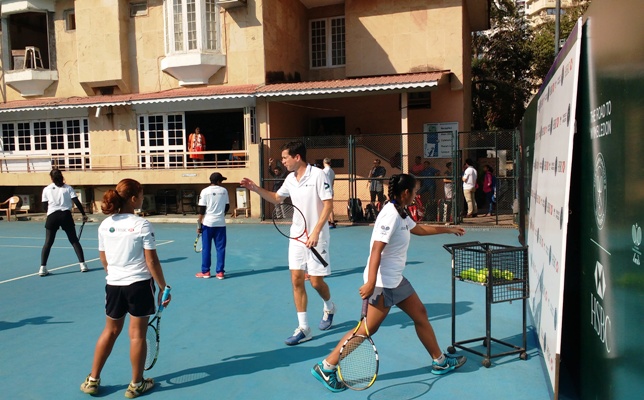
When Jim Courier beat Edberg in the semi-finals at Wimbledon in 1993, it left many surprised.
In 2002 we had two baseliners -- Lleyton Hewitt and David Nalbandian -- contesting the final. No attacking player has won Wimbledon since.
How do you explain the transition in the world's most prestigious tournament?
In 2002, the grass courts of Wimbledon were changed, as far as the type of grass is concerned.
It was 100 per cent ryegrass. Now ryegrass is a much tougher, harder-wearing, wider-stemmed grass. So when the ball hit the surface it used to skid and accelerate.
Now when the ball hits the surface it bounces much higher and the players have more time to play their shots.
It's also the evolution of the game. We have seen that in all other surfaces. They are a little bit slower, more abrasive... so there is more opportunity to play from the baseline.
From a personal point of view, I would love to see the attacking players, the volleyers come to the net. But, then, there was a time when grass court tennis was almost a serving competition. The longest rally was about making three shots.
Now when I look at the tennis at Wimbledon, when I commentate, for me it is better than it has ever been. The standard of play is amazing.
Don't you think these changes have taken away the X-factor from Wimbledon? The fact that made it different from the other three majors...
For me, if I look at international tennis, I think we have to be careful that the surfaces are not too similar.
Because if you look at the Australian Open, the French and the US Open, in terms of the speed and conditions, they are very similar.
It is important that we have a variety of surfaces, with varying speeds.
Sometimes we have faster indoor courts, faster hard courts, then we have the grass and the clay courts which are much, much slower. Then it gives players the opportunity to play different types of tennis.
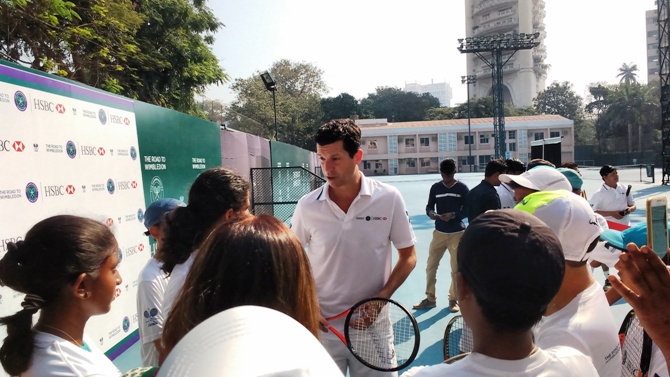
Continuing about the surfaces, the faster indoor surfaces (carpet) have disappeared; the grass courts have become much slower, even the hard courts have lost pace.
Hasn't it reduced the game to one particular style, with fewer variations on offer?
It's not completely the case, but you look at the way a majority of the players play. From top down, you look at Novak Djokovic, you look at Andy Murray... they do have a little bit of variation in their game.
But, yes, the vast majority of the points are about the serve and the ground strokes.
Federer is getting to the net more often than others. (Milos) Raonic was coming in frequently at the recent Australian Open.
But you are right. There is less variation and it is a little bit sad. I always liked it when there was contrasting styles among players.
Murray was very much at par with Djokovic, Federer and Rafael Nadal till 2013, the year he won the Wimbledon. He has lost considerable ground since, in terms of the head-to-heads... (Interrupts)
You look at his ranking. Murray is No 2. He hasn't fallen off the radar. He is in front of Federer and Nadal.
Who has beaten Djokovic?
Federer beat him in three of their seven meetings last year...
But not in the Grand Slams. Did he?
It is not right to say Murray has lost ground. He is still playing very, very, well.
Djokovic is playing some of the best tennis in the history of the game. So it is very difficult for the other players to beat him.
Djokovic has won 11 Grand Slams, and four of the last five. He was a finalist at the French. He is setting the bar the highest now. So it is a challenge for the other players to beat him.
It is about what Djokovic is doing, and not about what the others are not doing.
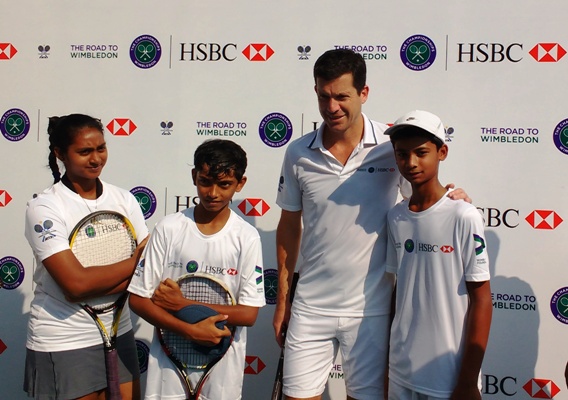
Coming to Britain's Davis Cup win last year, how important is it for the sport in the country?
It was an amazing victory, an incredible achievement!
Simply because if you look at the teams that have won in recent years. It was never about one man; it was about a good team.
Serbia (2010) had Djokovic, a couple of players in the top 20 in (Janko) Tipsarevic and (Viktor) Troicki and a good doubles team. Spain (2000, 2004, 2008, 2009 and 2011) had Nadal, and (David) Ferrer and so many others. Switzerland (2014) had Federer and (Stan) Wawrinka.
But when you come to Britain's win, Murray was such a big part of the whole achievement. Besides winning his singles matches, he also did very well in the doubles.
The amount of responsibility he took on was amazing, and for Britain to win the competition was much unexpected. But now I think we have to carry it forward and get more people to play the game of tennis.

Murray was ready to forego participation at the ATP World Tour Finals to be fit in time for the Davis Cup final and end Britain's long wait.
How do you explain the burden of expectations on Murray? How has he handled it?
You have to understand that a lot of the pressure is self-inflicted.
If he goes on court and he is thinking there's a 15,000 crowd, there are 15 million watching him on television, then he is putting a lot of pressure on himself.
But if he goes on court thinking I am playing great tennis, here is my gameplan, I am going to serve like this, play like this from the back court, then he will do well.
And I think he is very good at that. He doesn't let the outside factors affect him. He doesn't read the papers, doesn't listen to what is being said on television, so that he can concentrate on his tennis.
So when he played that Olympic final (2012) or that Wimbledon final (2013) he was mentally very, very good.
Women's tennis in Britain is looking up...
It's for the better. What Johanna Konta -- the Australian Open semi-finalist this year -- achieved in the past 12 months is fantastic.
She was in the 140s last year and is now in the 20s. Her progress sends a good message to the young players, that the only way to come up is through hard work. There's no other way to success.
Heather Watson is also doing very well in the last couple of years. But we need more and more players coming up.
Among the men, I think Kyle Edmund is doing very well now.


